Game Concept
The working title
- Eternal Echoes: Heroes of the Depths
The concept statement
Dive into a card-based roguelike adventure featuring classic holy trinity combat. Guide your party of heroes through ever-shifting dungeons overrun by formidable enemies and challenging boss battles.
Alter your abilities and gain powerful passives for a unique playstyle with every playthrough. Overcome the challenges and emerge victorious in this dynamic and unpredictable journey.
Genres
- Rogue-like
- The game incorporates randomised item and ability drops that offer a different experience each time you play, creating endless replayability, as well as perma-death mechanics with the items and abilities resetting after each run.
- Strategy – Turn-based strategy
- The game features turn-based combat, where players plan their moves and manage their party’s actions. The turn-based combat mechanics will be based on mana pools that allow for a limited number of actions each team turn, requiring management of resources and strategising to overcome each challenge.
- Doesn’t fit
- Card game – not deckbuilding, characters and abilities just represented as cards.
- Roleplaying – doesn’t provide any long-term character progression, and doesn’t provide a role that you are playing as your character as there isn’t a narrative.
Concept Creation Process and Influence
The concept for Eternal Echoes: Heroes of the Depths comes from a desire to blend turn-based holy trinity combat, with the strategy and replayability of roguelike mechanics. The concept process is a mashup approach, drawing inspiration from multiple existing video games, to create a unique and fun experience.
The interface design and user interaction are heavily influenced by Stray Path. The design of enemies, inventory, and stats to be user-friendly, ensure that all information and tools available to the player are clearly presented and easy to navigate, allowing players to focus their engagement with the core mechanics behind gameplay and developing their playstyle.
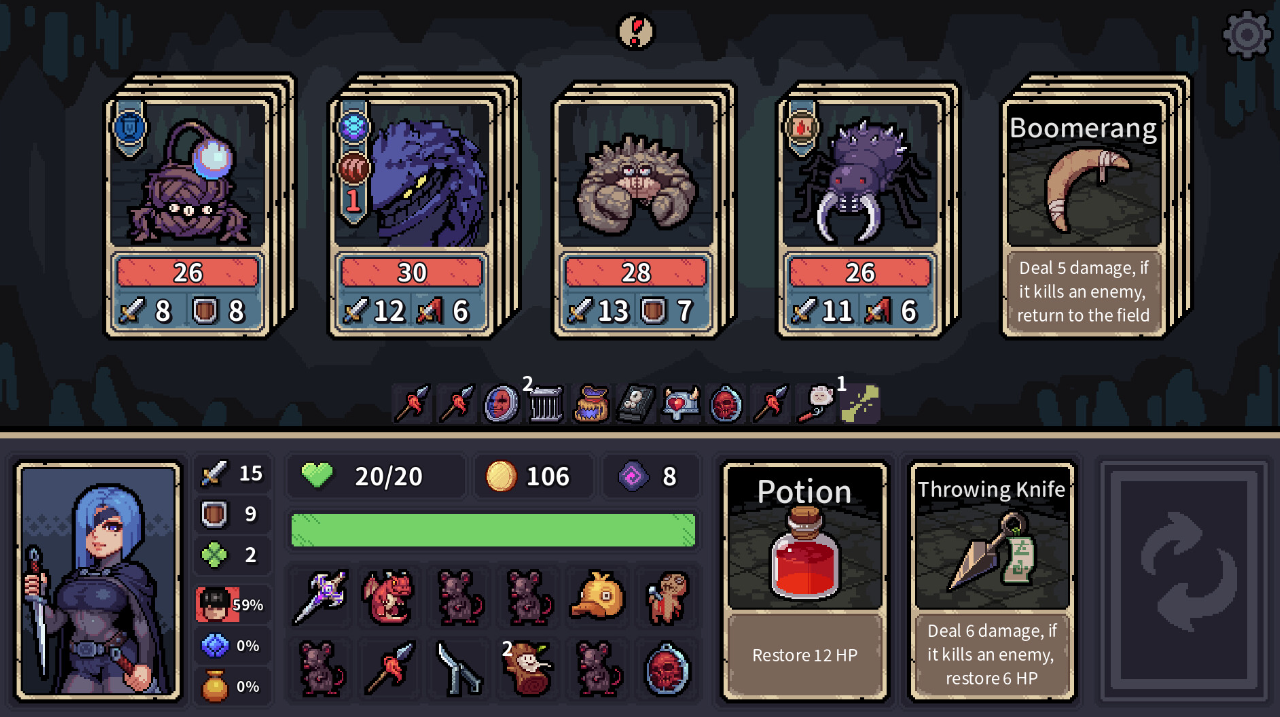
Figure 1: A screenshot from chx games’ game The Stray Path utilised to showcase as an example of a user-interface based game featuring card-based enemies and a hero, as well as inventory, stats, health, and ability cards.
The roguelike inventory and character progression system, through item and passive acquisition and character stat allocation each level, in The Last Flame provided great inspiration for Eternal Echoes: Heroes of the Depths. The ability system in The Last Flame also closely mirrors those in Eternal Echoes: Heroes of the Depths, focusing on a few very core actions, and allowing items or upgrades to enhance or change them.
The traditional concept of the holy trinity of tank, healer, and damage dealer roles was based on those in World of Warcraft. This heavily influences the style of gameplay I aim to achieve, as well as allows for a greater range of combat diversity and teamplay opportunities.
The mana system in Metaphor: ReFantazio, where the party has a total mana pool each turn, as opposed to each character having a traditional mana/rage system or Dungeons & Dragons action and basic action with spell points, provided significant influence for resource management in Eternal Echoes: Heroes of the Depths. Through the use of a party-based resource system for ability usage and basic attacks, Eternal Echoes: Heroes of the Depths encourages players to plan how to spend each turn in combat to best conquer their foes.
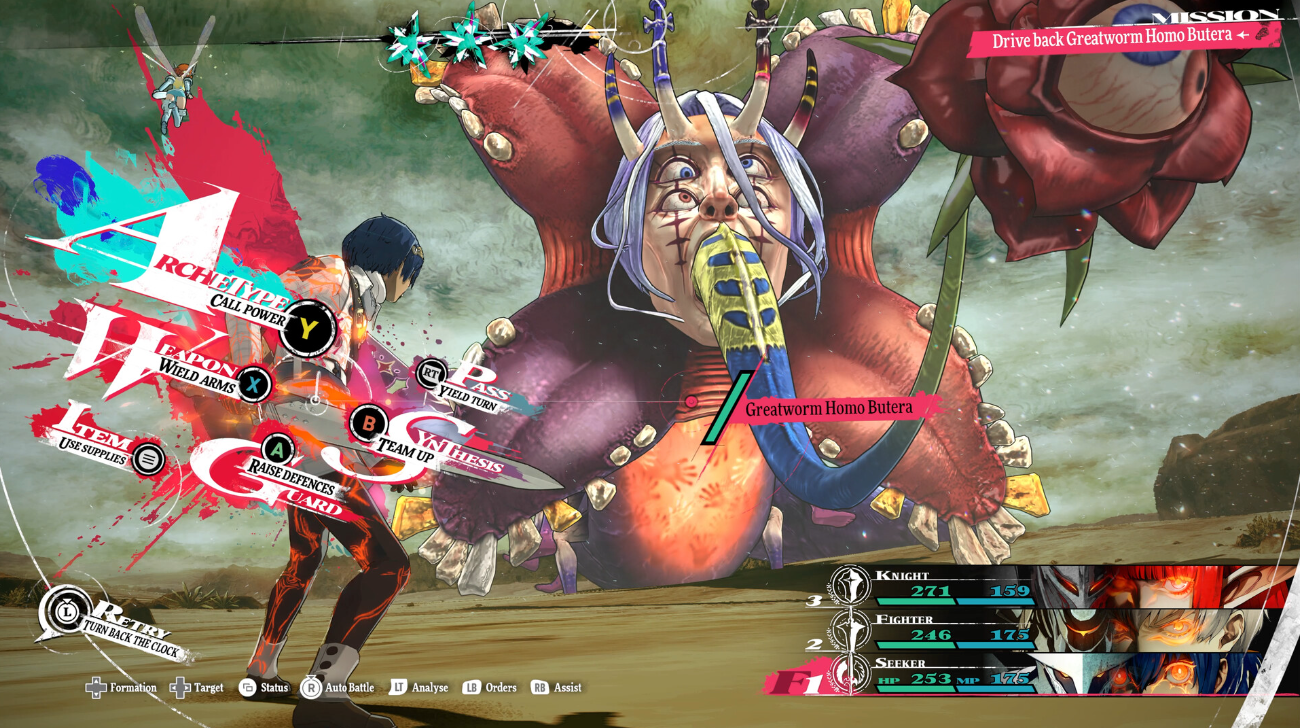
Figure 2: A screenshot from ATLUS’s game Metaphor: ReFantazio utilised to showcase as an example of a party-based mana system, as shown by the mana orbs in the top centre-left of the screen, allowing for the use of abilities each player turn.
Audience and Competitive Analysis
Eternal Echoes: Heroes of the Depths is designed for players that enjoy thoughtful and strategic gameplay, aimed particularly at casual audiences who appreciate the relaxed pace of turn-based mechanics. However, Eternal Echoes: Heroes of the Depths still offers elements that will attract semi-hardcore players through an accessible yet deep game system open to detailed optimisation and malleability.
Eternal Echoes: Heroes of the Depths is aimed at young adults to adults due to its tactical nature and pacing, which are more typically sought after by this age group, as well as both men and women, as strategic games often appeal to both genders, as well as providing content that doesn’t play into common gender-specific stereotypes.
Eternal Echoes: Heroes of the Depths will be accessible to players with a wide range of disabilities, such as colourblindness or deafness, as all abilities, items, stats, and live game reads such as health, will also have text explanations/display. Culturally, the game will appeal to a global audience by focusing on wider universal gameplay themes, largely avoiding social themes.
Although it incorporates elements from small and popular titles alike, targeting the usually niche audience of turn-based strategy and roguelike gamers, titles like Larian’s Baldur’s Gate 3 and Mega Crit’s Slay the Spire have shown that such games can achieve significant success. Eternal Echoes: Heroes of the Depths blends these foundational elements, with elements found in other genres, by using cards as an interface for abilities and actions, rather than focusing on traditional deck-building. Furthermore, we build on the holy trinity concept which rarely finds strong footing outside of MMORPGs, while implementing a party-based resource system that diverges from traditional turn-based games, usually relying on player-specific resources.
While these genres have found major success, similar titles often face challenges as they are often developed by smaller teams or indie studios that lack the funds to effectively market their games to a wider audience, resulting in low player numbers or sales, despite a player base's strong positive response.
Games such as Subset Games’ Into the Breach, a turn-based strategy game, earned a 94% positivity rating from almost 17,000 reviews on Steam, but struggled to break out of their niche community into mainstream gaming.
This shows how positively received games can struggle to break out of obscurity without substantial marketing support.
Game Treatment
In Eternal Echoes: Heroes of the Depths, a roguelike turn-based game centred around dynamic playstyles, build crafting, and strategic decision-making, you command a party of heroes tasked with purging ever-shifting dungeons of restless enemies and powerful bosses. Each run presents new challenges and formidable boss battles, testing your strategic prowess and adaptability. Craft unique builds to adapt your strategies and discover innovative ways to overcome dangerous challenges by gathering new items, unique passives, and powerful ability morphs.
Roguelike Adventure
- With each run, confront diverse groups of enemies, each crafted to challenge your builds in unique ways, demanding real-time adaptability. Enemy groups feature dynamic compositions inspired by traditional holy trinity, necessitating planned ability usage to ensure a fresh, engaging experience each time. Face multiple boss fights that put your strategic prowess to the test.
- Experience the suspense of permadeath, with the opportunity to try something new each run. Each time you venture out offers a new chance to test your skills and refine your strategies.
Turn-Based Strategy Gameplay
- Engage in deep tactical gameplay where careful planning and coordination are essential for success. Each decision you make can alter the course of the battle.
- Manage a shared mana pool for your party, making important decisions about resource allocation and ability usage. This collective resource system requires you to leverage the unique strengths of each party member, encouraging thoughtful and calculated gameplay.
Many Unique Builds
- Experiment with a vast array of ability morphs and passives, each offering unique interactions and defining your playstyle. Customise your heroes by selecting from randomised powers absorbed from your enemies, allowing you to create a playstyle that suits your goals.
- Gather new items to further focus your builds. With numerous combinations, every run presents an opportunity to explore new innovative strategies.
Holy Trinity Combat
- Focus on the classic roles of tank, healer, and damage dealer, each crucial for navigating the challenges before you. Coordinate your party’s actions to maximise their effectiveness, with each role contributing uniquely to your strategy.
- The interplay between roles adds depth to combat encounters. The healer keeps everyone in the fight with focused burst healing and group sustain, while the tank draws enemy fire and reflects damage to protect the team. Meanwhile, the damage dealers are crucial to your strategy. One delivers swift, powerful strikes to swiftly eliminate threats, and the other weakens foes and disables their abilities, setting them up for the team to take down key targets efficiently. Together, these roles create a system that ensures every battle is a test of decision-making and makes every victory rewarding.
Card-based UI-centric Design
- The card-based UI-centric design provides an intuitive and engaging way to interact with the game. Characters, abilities, and drops are represented as cards, replicating the feel of card-based games to offer a unique and engaging experience distinct from traditional deck-building titles. This design allows for easy management of items and abilities, allowing you to focus on gameplay. The visual nature of the cards creates an aesthetic experience that evokes the charm of tabletop games, yet delivered with a modern twist.
Concept Art
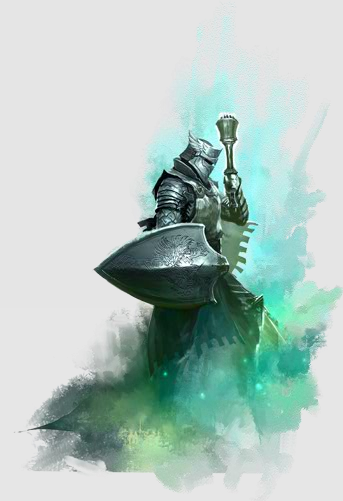
Figure 3: Art from ArenaNet’s Guild Wars 2 showcasing a Guardian in heavy armour, wielding a shield, and a bludgeoning weapon.
Figure 3 showcases the design I envision for the tank hero in the party, featuring heavy armour and weaponry, while presenting a stalwart posture that embodies its' role in the party of absorbing large amounts of damage away from the other party heroes.
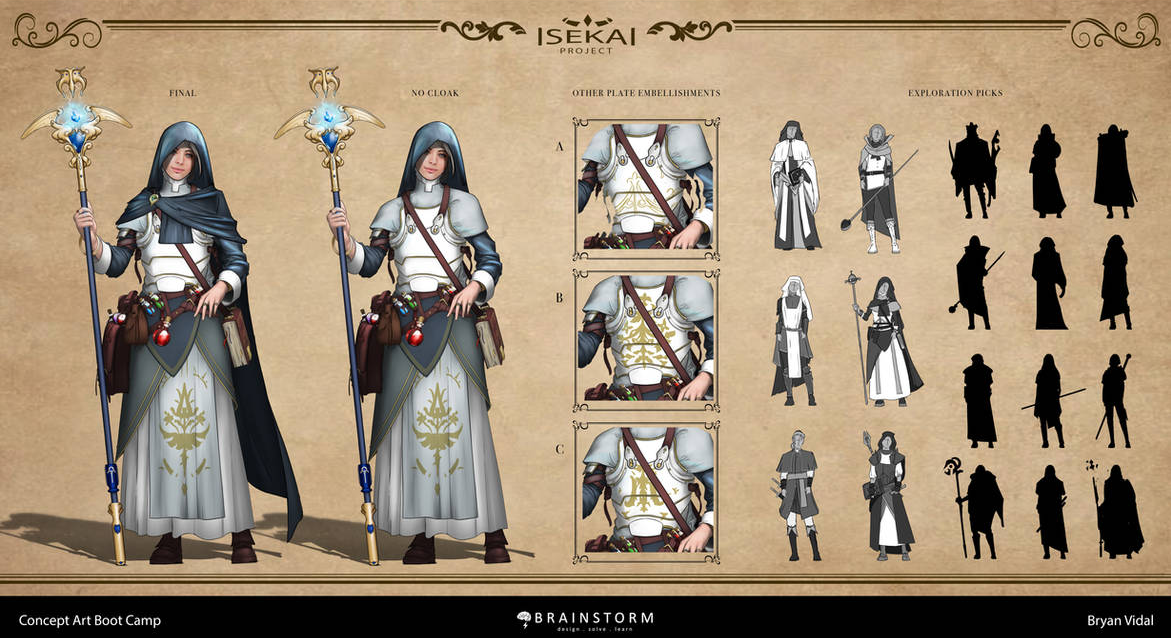
Figure 4: A concept art from Bryan Vidal showcasing a healer design for their Isekai Project, featuring long priest-like robes, a staff, and various alchemical accessories.
Figure 4 showcases the design I envision for the healer hero in the party, embodying the traditional light-armour healer class often seen in MMOs. The long robes and traditional magic items include a glowing staff, and a various assortment of potions, aiming to convey a sense of comfort most healer designs aim to achieve.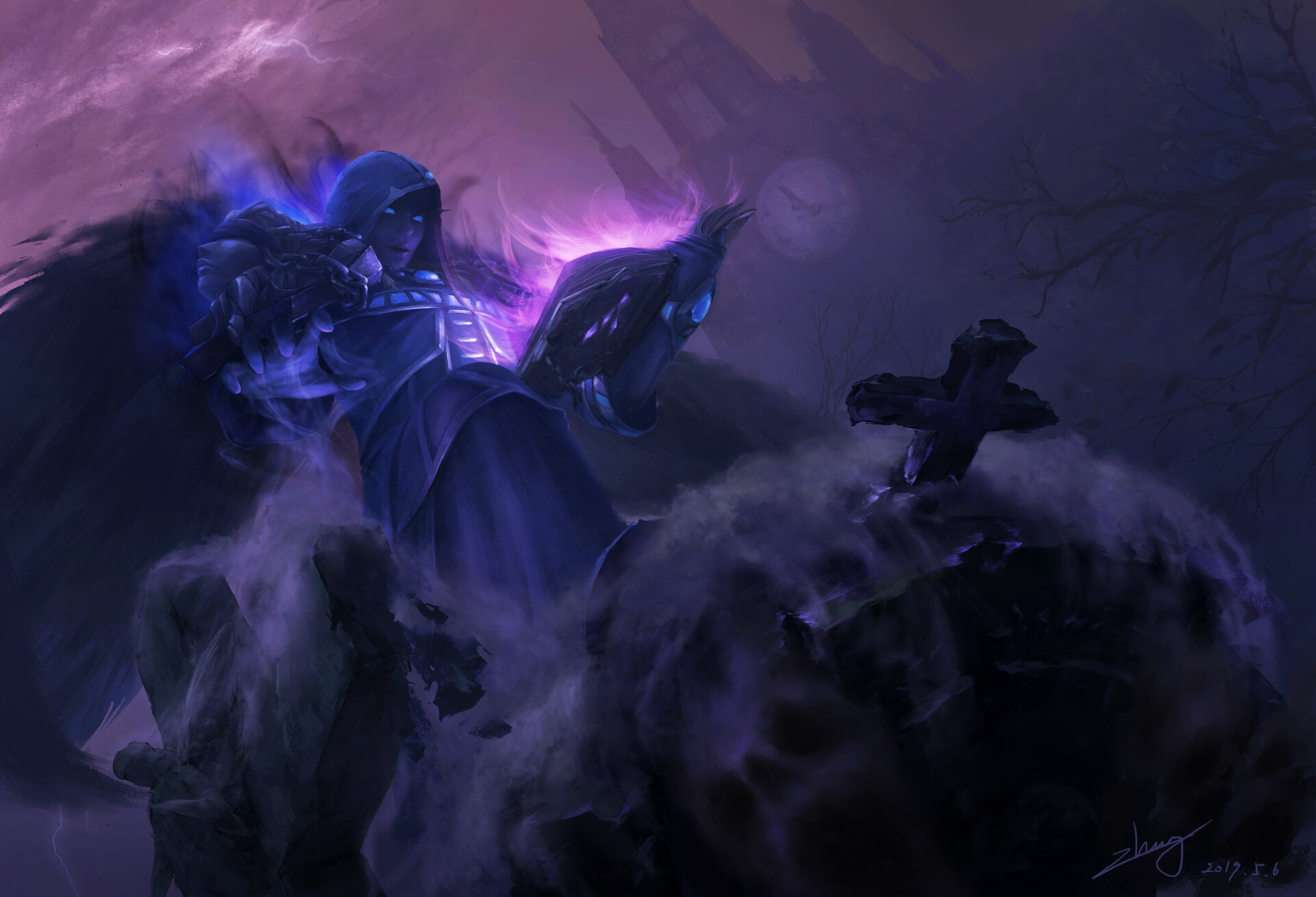
Figure 5: Art by Z Smith of a shadow priest from Blizzard’s World of Warcraft. The character wears long dark robes, casting a spell on enemies, amplified by a dark shadowy aura.
Figure 5 showcases the dark theme I envision for the debuffing damage mage hero in the party. The character is depicted in a hooded cloak, alluding to the mystery the debuffer character intends to purvey. Additionally, the dark, shadowy aura suggests an affiliation for the curse and debilitation-oriented spells the character will use to weaken and manipulate their enemies.
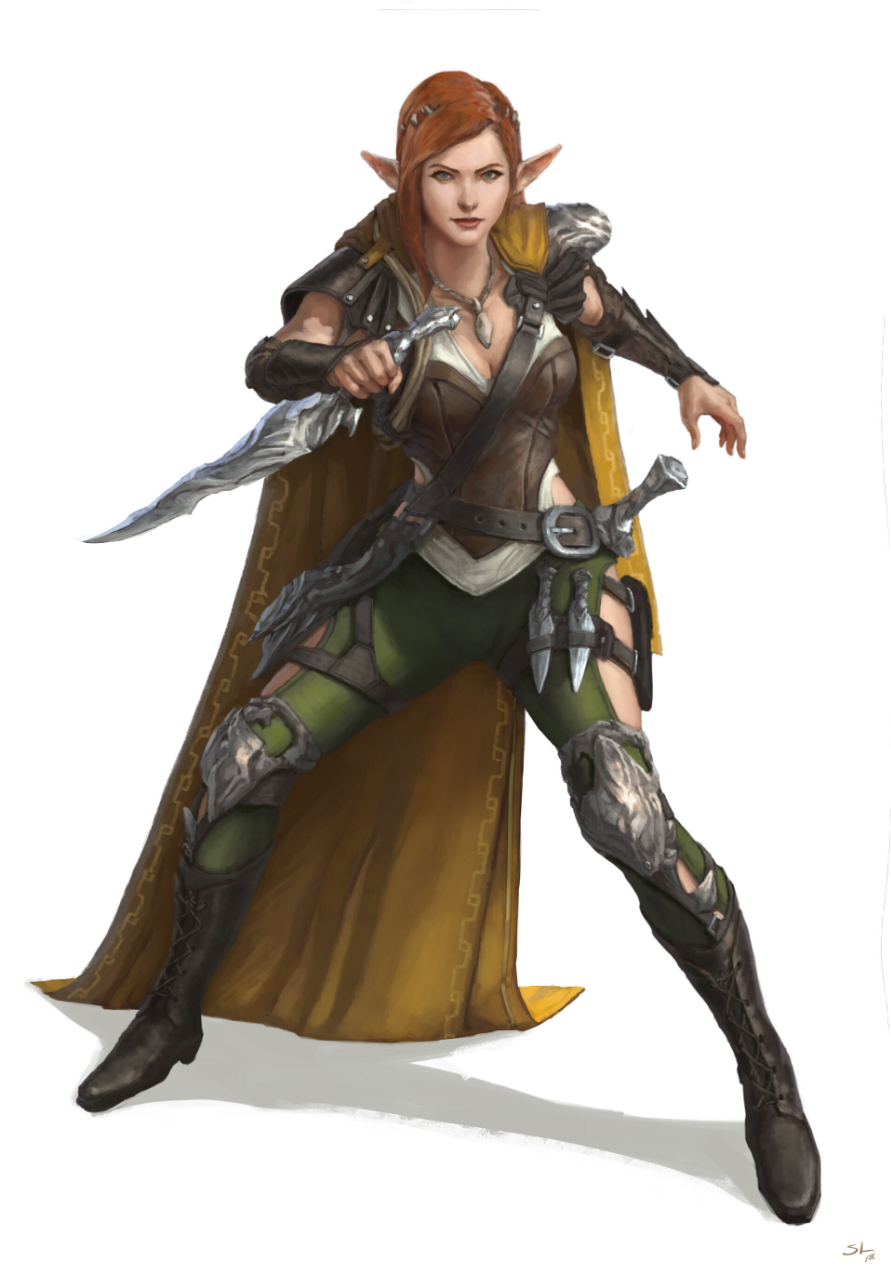
Figure 6: Art by Sam Leung of a fantasy rogue character design armed with daggers, throwing knives, and armoured in light leather-padded clothing while poised expecting confrontation.
Figure 6 presents a character that embodies the agile and stealthy gameplay the rogue class is often built around, with a vast array of knives and throwing knives utilised for quick and deadly strikes, before returning to obscurity. This aligns with the role the character will play in Eternal Echoes: Heroes of the Depths, that being a high-burst damage dealer rogue hero intended to work directly alongside the debuffing damage mage hero.
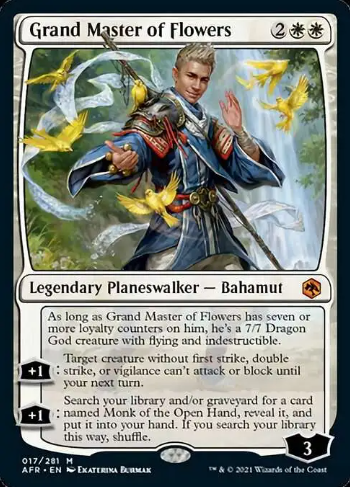
Figure 7: A card from Magic: The Gathering featuring the Grand Master of Flowers. The card includes art of a character, an ability subset presented as text below the artwork, and mana cost and card type identifiers.
Figure 7 presents how the cards will look for each hero and enemy within the game. It features a central piece of artwork of the hero or enemy to help the player visualise the fight. Additionally, the card will display their passives and abilities as well as their mana cost, however mana cost will be per ability, allowing the player to have clearly presented information about the tools available to them as they strategise each encounter.
References
Used for image in Figure 3 as a concept for the tank class.
ArenaNet. (2012, August 28). Guild Wars 2. https://www.guildwars2.com/en/the-game/professions/guardian/
Used for image in Figure 2 as an influence for the game concept, specifically for the party-wide mana system for ability usage.
ATLUS. (2024, October 11). Metaphor: ReFantazio. https://store.steampowered.com/app/2679460/Metaphor_ReFantazio/
Used as an influence for the game concept, specifically for the concept of holy trinity class roles.
Blizzard Entertainment. (2004, November 23). World of Warcraft. https://worldofwarcraft.blizzard.com/en-gb/
Used for image in Figure 1 as a concept for card and UI design and style.
chx games. (2025, February 7). Stray Path. https://store.steampowered.com/app/2531940/Stray_Path/
Used as an influence for the game concept, specifically for the ability system, item system, and character progression system.
Hotloop. (2025, January 10). The Last Flame. https://store.steampowered.com/app/1830970/The_Last_Flame/
Used for image in Figure 6 as a concept for the burst damage dealer class.
Leung, S. (2019). Rogue girl character. Artstation. https://www.artstation.com/artwork/3odwDg
Used for comparing elements of the game against to determine genres it matches.
List of video game genres. (2025, April 9). In Wikipedia. https://en.wikipedia.org/wiki/List_of_video_game_genres
Used for image in Figure 5 as a concept for the debuffer damage dealer class.
Smith, Z. (2019). blaspheme. Artstation. https://www.artstation.com/artwork/mq0Kod
Used for image in Figure 4 as a concept for the healer class.
Vidal, B. (2021, November 22). Isekai Project: Priestess. Deviant Art. https://www.deviantart.com/bryanvidal/art/Isekai-Project-Priestess-898616853
Used for image in Figure 7 as a concept for card aesthetics and potential layout.
Wizards of the Coast. (2021). Grand Master of Flowers. Retrieved from Card Kingdom website: https://toywiz.com/mtg-adventures-in-the-forgotten-realms-mythic-rare-grand-master-of-flowers-17/
Eternal Echoes: Heroes of the Depths
| Status | In development |
| Author | sammosenh |
| Genre | Strategy |
More posts
- Documentation and User Guide46 days ago
- Testing48 days ago
- Ability System and Basic Main Menu53 days ago
- Testing for Eternal Echoes: Heroes of the Depths55 days ago
- Turn Based System and Enemy Actions60 days ago
- Combat Core Implementation67 days ago
- Card Creation, Spawn, and Level Management Systems80 days ago
Comments
Log in with itch.io to leave a comment.
A very detailed and fleshed out game concept with clear inspiration and goals for what you want to achieve, and should be appealing to your target audience.
A game like this has the potential for consider amounts of scope creep, and is clearly very different to the styles of games we show you how to make in this unit. I encourage you to work out as early as possible if the associated difficulty with making a ui-heavy card-based game is within your (a) skillset and (b) available time, and think about which features are absolutely core to (a) making the game fun and (b) meeting the requirements of the Assignment 3C rubric.
The implementation of this game may very likely be done entirely on a UI canvas, or you can still work with sprites etc if you like, with world-space canvases to accomplish some text and ui elements. You may find yourself needing to learn about Scriptable Objects to represent the card data, and likely will need to find some tutorials to guide you on best approaches to make a game of this style.